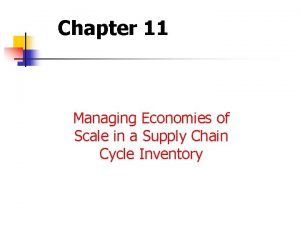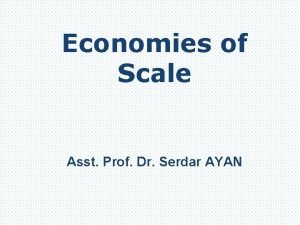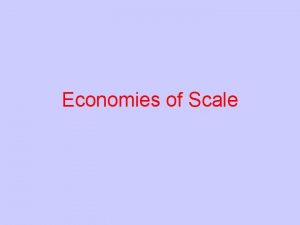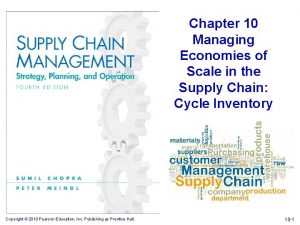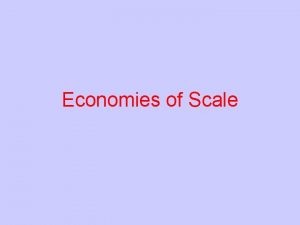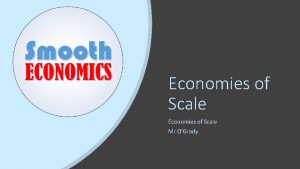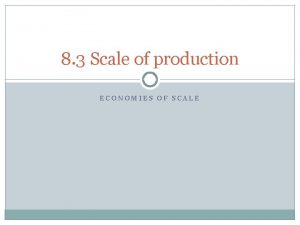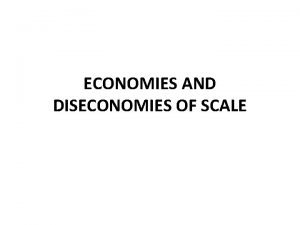TOPICS Economies Scale Of Production Dr Deshmukh V










- Slides: 10

TOPICS : Economies Scale Of Production Dr. Deshmukh V. V

ECONOMIES OF THE SCALE OF PRODUCTION According to Stinger, Economies of scales is synonyms of returns to scale. When scale of production is increased, up to a point, one gets economies of scale. Therefore, diseconomies of scale follow. Increasing returns to scale is the result of these economies. Marshall has divided economies of scale into two parts : Internal Economies External Economies

INTERNAL ECONOMIES Internal economies of scale are those economies which are internal to the firm. These arise within the firm as a result of increasing the scale of output of the firm. A firm secures these economies from the growth of the firm independently. The main internal economies are grouped under the following heads:

(I) Technical Economies: When production is carried on a large scale, a firm can afford to install up to date and costly machinery and can have its own repairing arrangements. As the cost of machinery will be spread over a very large volume of output, the cost of production per unit will therefore, be low. A large establishment can utilize its by products. This will further enable the firm to lower the price per unit of the main product. A large firm can also secure the services of experienced entrepreneurs and workers which a small firm cannot afford. In a large establishment there is much scope for specialization of work, so the division of labor can be easily secured (ii) Managerial Economies: When production is carried on a large scale, the task of manager can be split up into different departments and each department can be placed under the supervision of a specialist of that branch. The difficult task can be taken up by the entrepreneur himself. Due to these functional specialization, the total return can be increased at a lower cost. (iii) Marketing Economies: Marketing economies refer to those economies which a firm can secure from the purchase or sale of the commodities. A large establishment is in a better position to buy the raw material at a cheaper rate because it can buy that commodities on a large scale. At the time of selling the produced goods, the firm can secure better rates by effectively advertising in the newspapers, journals and radio, etc.

(iv) Financial Economies: Financial economies arise from the fact that a big establishment can raise loans at a lower rate of interest than a small establishment which enjoys little reputation in the capital market. (v) Risk Bearing Economies: A big firm can undertake risk bearing economies by spreading the risk. In certain cases the risk is eliminated altogether. A big establishment produces a variety of goods in order to cater the needs of different tastes of people. If the demand for a certain type of commodities slackens, it is counter balanced by the increase in demand of the other type of commodities produced by the firm. (vi) Economies of Scale: As a firm grows in size, it ispossible for it to reduce its cost. The reduction in costs, as a result of increasing production is called economies of scale. The economies of scale are obtained by the firm up to the lowest point on the firms long run average cost curve.

DISECONOMIES OF SCALE: Definition: The extensive use of machinery, division of labor, increased specialization and larger plant size etc. , no doubt entail lower cost per unit of output but the fall in cost per unit is up to a certain limit. As the firm goes beyond the optimum size, the efficiency of the firm begins to decline. The average cost of production begins to rise.

FACTORS OF DISECONOMIES: (I) Lack of co-ordination. As a firm becomes large scale producer, it faces difficulty in coordinating the various departments of production. The lack of co-ordination in the production, planning, marketing personnel, account, etc. , lowers efficiency of the factors of production. The average cost of production begins to rise. (ii) Loose control. As the size of plant increases, the management loses control over the productive activities. The misuse of delegation of authority, the redtapisim bring diseconomies and lead to higher average cost of production. (iii) Lack of proper communication. The lack of proper communication between top management and the supervisory staff and little feed back from subordinate staff causes diseconomies of scale and results in the average cost to go up. (iv) Lack of identification. In a large organizational structure, there is no close liaison between the top management and the thousands of workers employed in the firm. The lack of identification of interest with the firm results in the per unit cost to go up.

EXTERNAL ECONOMIES External economies of scale are those economies which are not specially availed of by. any firm. Rather these accrue to all the firms in an industry as the industry expands. The main external economies are as under:

(I) Economies of localization. When an industry is concentrated in a particular area, all the firms situated in that locality avail of some common economies such as (a) skilled labor, (b) transportation facilities, (c) post and telegraph facilities, (d) banking and insurance facilities etc. (ii) Economies of vertical disintegration. The vertical disintegration implies the splitting up the production process in such a manner that some Job are assigned to specialized firms. For example, when an industry expands, the repair work of the various parts of the machinery is taken up by the various firms specialists in repairs. (iii) Economies of information. As the industry expands it can set up research institutes. The research institutes provide market information, technical information etc for the benefit of alt the firms in the industry. (iv) Economies of by products. All the firms can lower the costs of production by making use of waste materials.

EXTERNAL DISECONOMIES: Definition: A firm or an industry cannot avail of economies for an indefinite period of time. With the expansion and growth of an industry, certain disadvantage also begin to arise. The diseconomies of large scale production are: (I) Diseconomies of pollution, (ii) Excessive pressure on transport facilities, (iii) Rise in the prices of the factors of production, (iv) Scarcity of funds, (v) Marketing problems of the products, (iv) Increase in risks.
 Madhavi deshmukh
Madhavi deshmukh Gunjan deshmukh blog
Gunjan deshmukh blog Gunjan deshmukh
Gunjan deshmukh Alur proses produksi produk
Alur proses produksi produk Managing economies of scale in a supply chain
Managing economies of scale in a supply chain Managing economies of scale in a supply chain
Managing economies of scale in a supply chain Serdar ayan
Serdar ayan Economies of scale advantages
Economies of scale advantages Managing economies of scale in a supply chain
Managing economies of scale in a supply chain Horizontal boundaries of a firm
Horizontal boundaries of a firm Economies of scale
Economies of scale




